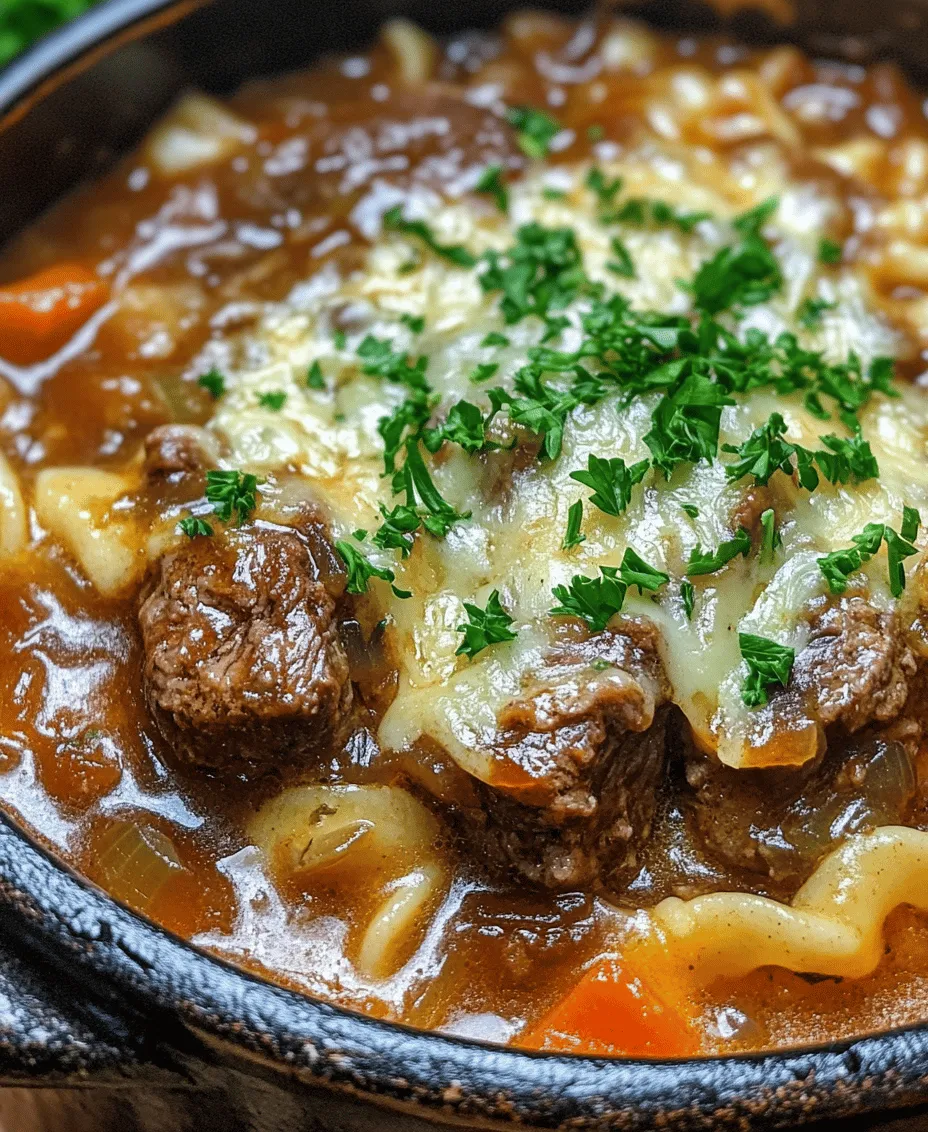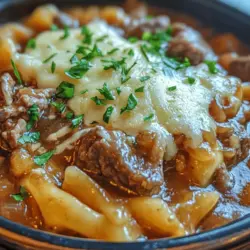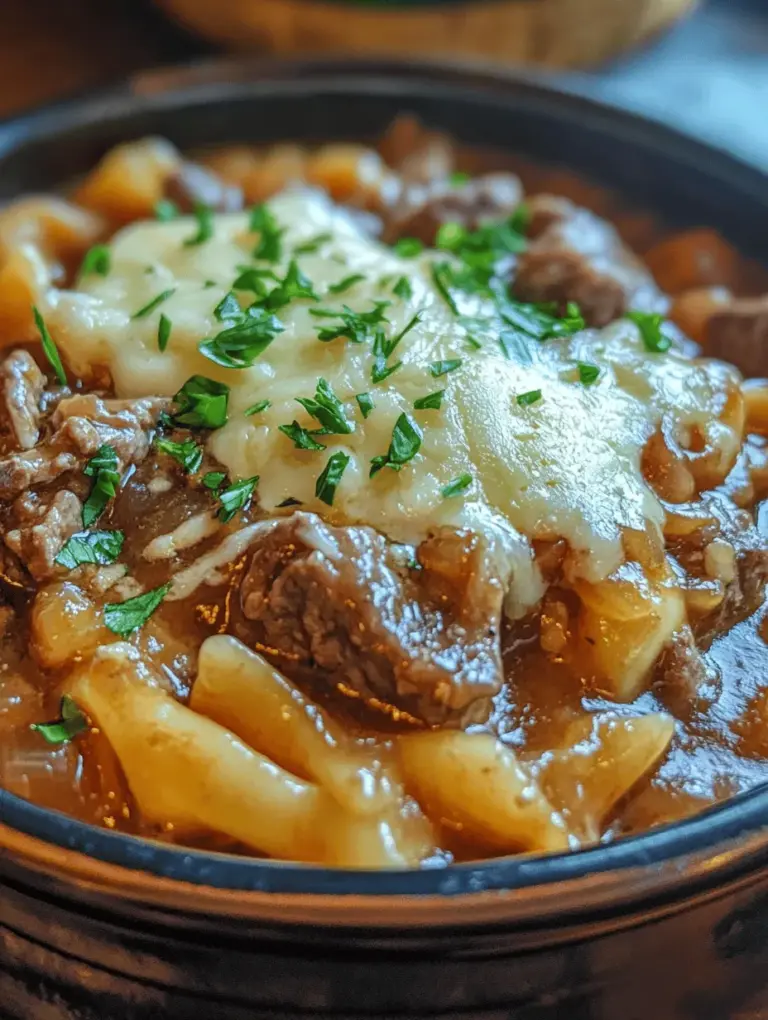Introduction
Discover the comforting allure of French Onion Beef and Noodles, a delightful dish that combines the rich flavors of caramelized onions, tender beef, and hearty egg noodles. This recipe not only satisfies your hunger but also evokes the warmth of a home-cooked meal. Perfect for chilly evenings or family gatherings, this dish brings together comforting elements that create a symphony of flavors in every bite.
In the world of comfort food, few dishes resonate as deeply as French Onion Beef and Noodles. It’s a meal that embodies the essence of cozy nights spent at home, the aroma of slowly simmered ingredients wafting through the kitchen, and the joy of sharing a hearty plate with loved ones. In this article, we will delve into the origins of this dish, explore its ingredients, and guide you through the preparation process, ensuring that you can recreate this culinary classic with ease.
Understanding the Dish
Exploring the Cultural Roots of French Onion Beef and Noodles
To appreciate the dish fully, it is essential to understand its roots. French onion soup is a beloved classic that dates back to the Roman times, with early versions featuring onions, broth, and the addition of stale bread. However, it was in France during the 18th century that the dish truly evolved into the rich, savory soup we recognize today, topped with gooey melted cheese and crusty bread.
The transition from soup to a full-fledged meal occurred as the cozy comfort of the traditional soup inspired cooks to add heartier ingredients, thereby giving birth to variations like French Onion Beef and Noodles. The introduction of tender beef and egg noodles transforms the soup into a substantial dish, perfect for serving as a main course. Its place in comfort food cuisine is firmly established, providing warmth and satisfaction that reminds us of home cooking.
Ingredients Breakdown
Essential Components of French Onion Beef and Noodles
To create the perfect French Onion Beef and Noodles, understanding each ingredient’s role is crucial. Here’s a breakdown of the key components that make this dish so irresistible:
– Beef Stew Meat: Choosing the right cut is essential for achieving that tender, melt-in-your-mouth texture. Cuts such as chuck roast or brisket are ideal as they have enough marbling to remain juicy during the cooking process. The slow cooking method allows these tougher cuts to break down, resulting in a flavorful and tender beef.
– Onions: The star of the show is undoubtedly the onions. Caramelizing them slowly brings out their natural sweetness, which is a fundamental flavor in this dish. Yellow onions are typically preferred due to their balanced sweetness, but you can also experiment with sweet onions for a milder flavor or red onions for a hint of color and sharpness.
– Garlic and Herbs: The addition of garlic enhances the flavor profile, adding depth and complexity. Fresh thyme is a classic herb that complements the onions and beef beautifully. A splash of Worcestershire sauce also adds umami, rounding out the flavors and providing a savory richness.
– Beef Broth: A good quality beef broth is vital for creating a rich base. It not only provides moisture but also infuses the dish with a robust flavor. Homemade broth is ideal, but store-bought options can work just as well if you’re short on time.
– Egg Noodles: These noodles are the ideal vehicle for soaking up the delicious sauce. Their chewy texture contrasts beautifully with the tender beef and caramelized onions. They cook quickly, making them a convenient option for a weeknight meal.
– Cheese: The choice of cheese can elevate the dish to another level. Gruyère is often regarded as the classic choice due to its nutty flavor and excellent melting qualities. Swiss cheese can also be used for a milder taste, so feel free to choose based on your preference.
– Fresh Parsley: As a finishing touch, a sprinkle of fresh parsley not only adds a pop of color but also a hint of freshness that lightens the richness of the dish.
Preparation Steps
Detailed Instructions for Perfecting French Onion Beef and Noodles
Now that we have a comprehensive understanding of the ingredients, let’s dive into the preparation process. Follow these detailed steps to ensure your French Onion Beef and Noodles turn out perfectly every time.
1. Caramelize the Onions: Begin by slicing your onions thinly. In a large Dutch oven or heavy-bottomed pot, heat a tablespoon of olive oil over medium heat. Once hot, add the sliced onions and a pinch of salt. Stir occasionally to prevent burning, allowing them to cook down and caramelize for about 30-40 minutes. The goal is to achieve a deep golden brown color, which enhances their sweetness and flavor.
2. Add the Garlic and Beef: When the onions are caramelized, push them to the sides of the pot, and add another tablespoon of oil if necessary. Add minced garlic and cook for about a minute until fragrant. Next, add your beef stew meat, season it with salt and pepper, and brown it on all sides. This step is crucial as it adds depth to the dish.
3. Deglaze the Pot: Once the beef is browned, it’s time to deglaze the pot. Pour in a splash of beef broth, scraping the bottom of the pot to release the flavorful brown bits. This process adds even more richness to your dish.
4. Incorporate the Broth and Herbs: After deglazing, pour in the remaining beef broth. Add the caramelized onions back into the pot along with fresh thyme and a splash of Worcestershire sauce. Stir to combine the ingredients and bring the mixture to a gentle simmer.
5. Simmer the Stew: Cover the pot and let it simmer gently for about 1.5 to 2 hours. This slow cooking will allow the beef to become tender and the flavors to meld beautifully. Check occasionally, stirring and adding more broth if needed to keep everything moist.
6. Cook the Egg Noodles: While the beef is simmering, cook your egg noodles according to the package instructions in a separate pot. Aim for al dente, as they will continue to cook when combined with the stew.
7. Combine and Serve: Once the beef is fork-tender and the flavors are well developed, remove the pot from heat. Stir in the cooked egg noodles until they are well coated with the sauce. Serve the dish hot, garnished with shredded Gruyère cheese and fresh parsley for a delightful finish.
By following these structured steps, you can create a dish that not only warms the heart but also tantalizes the taste buds. The combination of caramelized onions, tender beef, and hearty noodles creates a delightful meal that is sure to become a family favorite. Enjoy the process of making this dish as much as the delicious results!

Browning the Beef: Techniques for Achieving the Best Flavor
Browning the beef is a crucial step in making French Onion Beef and Noodles. This process not only enhances the flavor but also creates a rich base for your dish. To achieve the best results, start with high-quality beef, such as chuck roast or sirloin. Cut the beef into bite-sized pieces to ensure even cooking.
When browning the beef, use a heavy-bottomed skillet or Dutch oven. This type of cookware retains heat well, allowing for a perfect sear. Ensure the pan is hot before adding the beef; this helps to lock in moisture and flavor. Don’t overcrowd the pan, as this can lead to steaming rather than browning. Instead, work in batches if necessary. Sear the beef on all sides until a deep golden-brown crust forms, which typically takes about 3-4 minutes per side. This Maillard reaction is what gives the dish its complex flavors.
Tip: After browning the beef, deglaze the pan with a splash of broth or wine. This process lifts the flavorful browned bits stuck to the bottom, incorporating them into your sauce for added depth.
Caramelizing Onions: Tips for Perfect Texture and Taste
Caramelizing onions is an art that elevates the flavor profile of your dish. To start, slice your onions thinly to ensure they cook evenly. Yellow onions are ideal for this recipe due to their perfect balance of sweetness and sharpness.
Heat a tablespoon of oil or butter in the same skillet used for the beef over medium heat. Once the fat is hot, add the sliced onions and a pinch of salt. The salt helps to draw out moisture, aiding in the caramelization process. Stir the onions occasionally, allowing them to cook slowly. You’ll want to aim for a golden-brown color, which usually takes about 15-20 minutes. If the onions start to stick to the pan, you can add a bit of water or broth to loosen them.
Tip: For an extra layer of flavor, consider adding a teaspoon of sugar during the caramelization process. This will enhance the natural sweetness of the onions, giving your dish a richer taste.
Infusing Flavors: The Importance of Garlic and Thyme
Garlic and thyme are essential components in French Onion Beef and Noodles, contributing to the overall aroma and flavor. After the onions are caramelized, add minced garlic to the skillet. Garlic should be added towards the end of the onion cooking process, as it cooks much faster and can burn easily. Sauté the garlic for about 30 seconds until fragrant.
Thyme, whether fresh or dried, adds a wonderful earthy note. If using fresh thyme, add a few sprigs directly into the pot; if using dried thyme, a teaspoon will suffice. This herb complements the beef and onions beautifully and enhances the overall depth of flavor.
Tip: Consider using additional herbs like rosemary or bay leaves for a more complex flavor profile, but be cautious not to overpower the dish.
Simmering to Tenderness: The Science Behind Slow Cooking Beef
Once the beef and onions are ready, it’s time for the magic of slow cooking. Add the browned beef back into the skillet along with the caramelized onions, garlic, and thyme. Pour in beef broth, ensuring the meat is fully submerged. Bring the mixture to a gentle simmer. The key to tender beef is to cook it low and slow. Allow the beef to simmer for at least 1.5 to 2 hours, or until it is fork-tender.
The slow cooking process breaks down the collagen in tougher cuts of beef, resulting in a tender and flavorful dish. Stir occasionally and check for doneness. If the liquid reduces too much, you can add more broth to maintain the desired consistency.
Tip: For added flavor, consider incorporating a splash of red wine or Worcestershire sauce to the broth. This will enhance the richness and complexity of the dish.
Cooking Noodles: Timing and Texture for Al Dente Perfection
While your beef is simmering, it’s time to prepare the noodles. For this recipe, egg noodles are a classic choice, but feel free to use your favorite type. Bring a large pot of salted water to a boil. Add the noodles and cook according to package instructions, aiming for an al dente texture, which typically takes about 8-10 minutes.
Once cooked, drain the noodles and toss them with a bit of olive oil to prevent sticking. This step is essential, as you want the noodles to maintain a slight bite, allowing them to absorb the flavors from the beef and sauce without becoming mushy.
Tip: If you prefer a creamier texture, consider adding a splash of heavy cream or sour cream to the noodles after draining. This will create a luxurious base for the beef and sauce.
Melting Cheese: Techniques for a Gooey, Delicious Topping
The final touch for your French Onion Beef and Noodles is the cheese. Traditionally, Gruyère cheese is used for its excellent melting properties and rich flavor. Grate a generous amount of cheese and sprinkle it over the beef and noodles during the last 10 minutes of cooking.
To achieve that gooey, bubbling effect, place the skillet under the broiler for a few minutes once everything is cooked. Keep a close eye on it to prevent burning. The cheese should melt beautifully and turn golden brown, creating a deliciously appealing topping.
Tip: For added flavor, consider mixing in a bit of Parmesan cheese with the Gruyère, as it enhances the umami richness and adds a delightful salty kick.
Serving Suggestions: Creating the Perfect Meal Experience
Ideal Pairings: Side Dishes and Beverages to Complement the Dish
To create a well-rounded meal, consider pairing your French Onion Beef and Noodles with simple side dishes. A crisp green salad with a tangy vinaigrette can provide a refreshing contrast to the richness of the main dish. Alternatively, roasted vegetables drizzled with olive oil and seasoned with herbs can add another layer of flavor.
For beverages, a light-bodied red wine, such as Pinot Noir, complements the dish beautifully. If you prefer non-alcoholic options, a sparkling water with a twist of lemon can cleanse the palate effectively.
Presentation Tips: Serving Style for an Appetizing Display
Presentation plays a vital role in the dining experience. Serve the French Onion Beef and Noodles in shallow bowls to allow the cheese to take center stage. Garnish with freshly chopped parsley or thyme for a pop of color and freshness. Additionally, serving with crusty bread on the side is a delightful way to soak up the rich sauce.
Tip: Consider using a cast-iron skillet for serving, as it retains heat well and adds a rustic charm to the table setting.
Storing Leftovers: Best Practices for Preserving Flavors
If you’re lucky enough to have leftovers, store them in an airtight container in the refrigerator. The dish can last for up to 3-4 days. To reheat, add a splash of broth to the mixture in a saucepan over low heat, stirring occasionally until warmed through.
For longer storage, consider freezing the beef and noodles. Allow the dish to cool completely before transferring it to a freezer-safe container. It can be frozen for up to 3 months. When ready to enjoy, thaw it overnight in the refrigerator and reheat on the stove.
Nutritional Insights: Evaluating the Health Aspects of French Onion Beef and Noodles
Caloric Breakdown per Serving
Understanding the nutritional aspects of your meal is essential, especially when indulging in a rich dish like French Onion Beef and Noodles. On average, one serving contains approximately 400-500 calories, depending on the specific amounts of beef, noodles, and cheese used. This makes it a hearty meal that is both satisfying and filling.
Nutritional Benefits of the Main Ingredients
The main ingredients in this dish provide several nutritional benefits. Beef is a fantastic source of protein, essential for muscle repair and growth. It also supplies important nutrients like iron, zinc, and B vitamins. Onions, rich in antioxidants, promote heart health and can help regulate blood sugar levels. Egg noodles offer carbohydrates, which provide energy, while cheese contributes calcium and protein.
Balancing Indulgence and Nutrition
While French Onion Beef and Noodles is certainly a comfort food, it can still fit into a balanced diet. To make it a bit healthier, consider using whole grain noodles, reducing the amount of cheese, or incorporating more vegetables into the dish. This way, you can enjoy the rich flavors while still being mindful of your nutritional intake.
Conclusion
In conclusion, French Onion Beef and Noodles is not just a recipe; it’s an experience that brings comfort and satisfaction with every bite. By understanding its origins, mastering the preparation steps, and exploring serving suggestions, you can create a dish that is not only delicious but also a cherished addition to your culinary repertoire. Whether it’s a family dinner or a gathering with friends, this dish is sure to warm hearts and fill bellies. Embrace the joy of cooking and savor the rich flavors that come together in this delightful meal.


